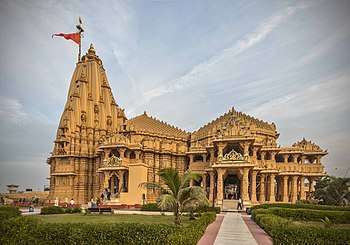1. Introduction
In 2020, a groundbreaking discovery was made beneath Gujarat’s Somnath Temple using advanced Ground-Penetrating Radar (GPR). Researchers found a three-tiered structure hidden under the temple complex, revealing new insights into its history and architecture.
2. Investigation and Discovery
- Technology Used: Ground-Penetrating Radar (GPR)
- Depth of Structure:
- First level: 2.5 meters deep
- Second level: 5 meters deep
- Third level: 7.3 meters deep
- Shape: L-shaped configuration
- Additional Findings: Another underground structure was detected near the security checkpoint
3. Architectural Features
- Construction Style: Gujarat architectural style, influenced by the 11th-century Chalukya dynasty
- Material Used: Red and white stones
- Structural Layout:
- Lower Level: Two sanctuaries – one for Lord Shiva with a Shiva Linga and one for Goddess Durga
- Middle Level: A spacious assembly hall
- Upper Level: A large open courtyard
- Dimensions: 100 feet long, 50 feet wide, 30 feet high
4. Purpose and Significance
- Uncertain Purpose: Possible protective structure or a religious complex
- Artifacts Found: Pillars, carvings, and other artistic elements
- Historical Context:
- Originally built in ancient times, exact date unknown
- Rebuilt multiple times:
- 7th century by the Maitraka dynasty
- 9th century by Nagabhata II
- 12th century by Chalukya king Kumarapala
5. Recent Developments
- The Somnath Temple Trust has requested permission from the Archaeological Survey of India (ASI) for excavations
- Further research is planned to unearth more relics and understand the site’s full history
6. Summary
A hidden three-story structure beneath Somnath Temple was discovered using GPR technology in 2020. It features an L-shaped design, two temples, and a large hall. Built in the Gujarat architectural style, it dates back to the 11th century and may have served religious or protective purposes. The discovery sheds light on the temple’s history, prompting further archaeological research.



